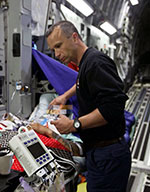Michael Callahan: Alumni Profile
By Matt Windsor |
|
Michael Callahan directing an air evacuation of a U.S. serviceperson with infectious disease from Africa |
Michael V. Callahan, M.D., DTM&H (U.K.), M.S.P.H., doesn't wear a military uniform, but he plays a crucial role in keeping Americans safe by beefing up the nation's defenses against disease.
For the past seven years, Callahan, a 1995 School of Medicine graduate, has been a program manager for the Defense Advanced Research Projects Agency (DARPA), the American military’s secretive R&D center. Callahan was recruited while working overseas “to work on fast-paced solutions to health threats,” he says. His biggest mission: Create a government-funded drug research and production capability focused strictly on national priorities, such as defense and pandemic preparedness, rather than profits. The Department of Defense had no idea how to make drugs, but they knew they had to learn, Callahan recalls.
Rush Request
“The military is most concerned about diseases of the tropics and diseases of bioterrorism, but these are rare globally,” Callahan says. “Though you might have 170,000 deaths per year from yellow fever, that’s not going to be a money maker for a drug company, so they aren’t interested.”
Callahan’s solution involved a special forces approach. His team identified promising work in U.S. labs, offering researchers the funding and equipment they needed to turn their discoveries into patient-ready treatments. In 28 months, DARPA-funded projects created six new vaccines, leveraging taxpayer dollars into economic payback at a ratio of up to 11:1. “It’s been wildly successful,” Callahan says.
Callahan also developed a “twinning” strategy, searching for treatment approaches for related diseases that would interest the military or government (such as bird flu, with its potential to cause a pandemic) as well as drug companies and venture capitalists (the regular flu). These players could then help fund development costs needed to bring the products to market.
Out with the Eggs
Another major goal was replacing the traditional egg-based methods of producing vaccines, which can take “eight years to forever” to develop and six months or more to produce. Callahan’s team launched the Accelerated Manufacturing of Pharmaceuticals project, which found a solution in tobacco plants. Grown in “bug-free hydroponic facilities,” the plants can be easily and rapidly altered to express the needed vaccine products in a matter of weeks. “One 2,000-square-foot chamber consisting of 12 trays can produce up to three million doses of flu vaccine” in a month’s time, Callahan says.
Faster, Higher, FartherA lifelong mountain climber, Callahan is using a “twinning” approach to help acclimatize mountaineers to high-altitude conditions rapidly. A therapy using an inhalable gas—similar to an albuterol asthma inhaler, Callahan says—is currently in clinical trials on Tanzania’s Mount Kilimanjaro.The military implications are obvious. “Our soldiers in Afghanistan have to chase bad guys uphill at anywhere from 14,000 to 18,000 feet,” Callahan says. “At the moment, it takes 24 to 46 days to truly acclimatize to those conditions, especially since most of our troops are coming from U.S. bases at or near sea level.” But, he adds, the same treatment “could also treat pulmonary arterial hypertension or chronic hypoxia from lung disease,” which affect millions of civilians worldwide. |
Meanwhile, the Prophecy program seeks to predict emerging virus threats and develop vaccines or other treatments to contain them. Working in small teams with foreign governments, DARPA has established an early warning system that can rapidly collect and share information across borders.
“In a perfect world, doctors would see a new virus, sequence it, and e-mail us the genetic information,” Callahan says. Within a matter of days, Callahan’s team can identify the virus and its mechanism of action, letting health workers know if there is an existing vaccine that will help. If not, Callahan says, “we can create a new one and produce between 30 and 160 million doses within a month.”
Path to Birmingham
The Boston native started traveling overseas on relief missions in the early 1980s; in 1988, he founded a charter organization that provided emergency medical evacuation and refugee medical care in developing countries.
He determined to pursue a career in infectious diseases, receiving a master’s degree focusing on international health from the UAB School of Public Health. Soon afterward, he entered the School of Medicine, where he says he had “great training.” Today, Callahan continues to work with UAB colleagues including David Freedman, M.D., in the Division of Infectious Diseases, and several members of the Division of Pulmonary, Allergy, and Critical Care Medicine.
Forward Thinking
Now Callahan says he is ready for new adventures. In fall 2012, he returned to Massachusetts General Hospital, where he has worked for three months each year in the Division of Infectious Diseases, to run a new disease surveillance and antiviral clinical trials program in Africa and southeast Asia. He hasn’t relinquished his defense role, however. “I still have federal responsibilities to the White House for pandemic preparedness and exotic disease outbreaks, which will continue for the near future,” he says.
Meanwhile, Callahan is excited to see how techniques and strategies he initiated at DARPA can be adapted far beyond infectious diseases. The White House and the National Institutes of Health are both interested in the models, Callahan says. “The technology is cool,” he says, “but the experimental business strategy they allowed me to try will have implications across government.”